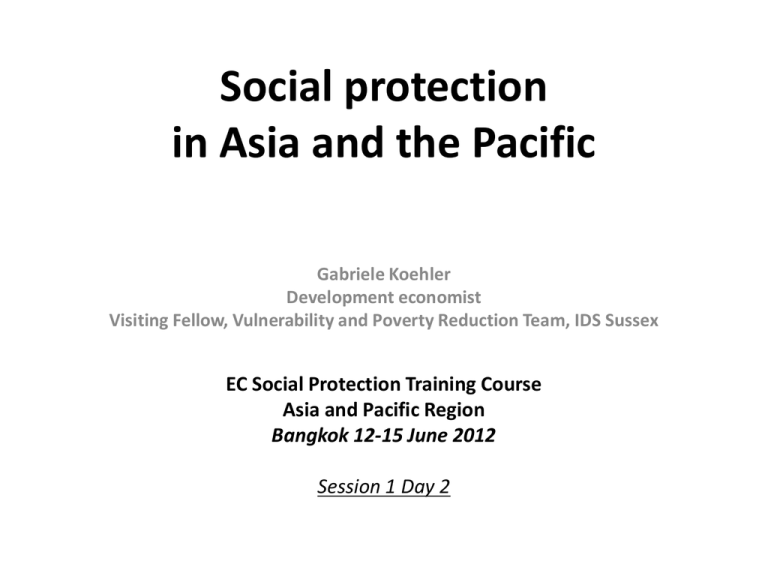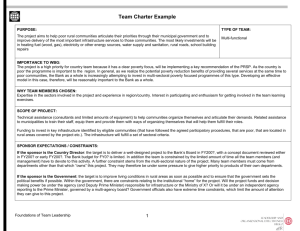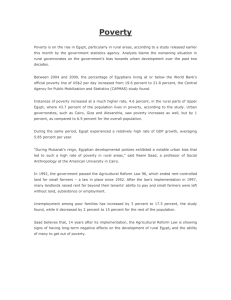Social protection in Asia and the Pacific region
advertisement

Social protection in Asia and the Pacific Gabriele Koehler Development economist Visiting Fellow, Vulnerability and Poverty Reduction Team, IDS Sussex EC Social Protection Training Course Asia and Pacific Region Bangkok 12-15 June 2012 Session 1 Day 2 Overview of session: I. Introduction: the “quiet revolution” – snapshot from the global South II. The Asian-Pacific big picture III. Social protection schemes and instruments: interactive discussion IV. Summarising & outlook – quick quiz on “good” social protection I. The “quiet revolution” • Social protection gaining massive support in multilateral fora, in regional agreements, in countries, and in North-South and SouthSouth development cooperation • Numerous, and many large schemes in place across the globe • Regional specifics • Asia with some of the largest and most innovative schemes globally Social protection reforms in middle- and low-income countries across the globe • Asignación Universal por Hijo para Protección Social in Argentina • Bolsa Familia (and the new Brasil Sem Miséria) programme) in Brazil • Productive Safety Nets in Ethiopia • Mahatma Gandhi National Rural Employment Guarantee in India • Di bao reforms in China • Progresa and Oportunidades in Mexico. Regional typologies of SP • Latin America – addressing hunger and poverty, “human development oriented”, conditional cash transfers • Africa – poverty and asset building, predominantly unconditional transfers • South Asia – hunger, poverty, social exclusion, mixture of conditional and unconditional, employment schemes as a frequent format • East Asia and Pacific – addressing risk, mixed conditional and unconditional cash transfers, CCTs in Indonesia or Philippines; pensions in East Asia; universal health systems in China, Philippines, Thailand • Central Asia - emphasis on cash transfers to address transition poverty Conditional Cash Transfers in Latin America Argentina Programa Familias Bolivia Beca Futuro Brazil Bolsa Familia, Bolsa Escola Chile Chile Solidario Colombia Familias en Accion Program Costa Rica Programa Superemonos Ecuador Bono de Desarrollo Humano El Salvador Red Solidaria Honduras Programa de Asignacion Familiar Mexico Progresa, Oportunidades Nicaragua Red de Proteccion Social Unconditional Cash Transfers in sub-Saharan Africa Social protection: South Asia Foodrelated measures •Cooked school meals (IND) •Subsidized PDS (IND, NPL, BGD) •Subsidized grain prices Social Assistance •Universal old age pension (NPL) •Benazir Income Support Program (PAK) •Child benefit (NPL) •Unorganized sector health insurance (IND) Public works •National Rural Employment Guarantee (IND) •Employment Generation Programme for the Poorest (BGD) •Karnali Programme; Employment Guarantee Act (NPL) •Employment generation for rural unskilled workers (PAK) Affirmative action •Secondary school stipend for girls (BGD) • Education for all (NPL) •Child grants for girls (IND) •Rural development and community based interventions (IND) Human rights •Right to food/National Food Security Act (IND) •Mid-day meal (IND) •Right to education (all) •Right to health services (all) •Right to work (IND) •Right to information (IND, BGD, NPL) II. An Asian-Pacific snapshot – challenges & selected country examples Unequal progress in sub-regions The Asia-Pacific share of the world’s deprived Source: Asia-Pacific Regional MDG report 2011/12 (ESCAP/ADB/UNDP) Social protection coverage Cambodia China Minimum Living Subsidy Scheme (DiBao) since 1997 Description •The scheme pays the difference between the monthly income of poor households and an income minimum Objectives •To assist poor households in urban China •to provide five guarantees for the elderly in the areas of housing, food, clothing, medical care, and burial expenses •transfers to childless and elderly people. Monthly transfers •102 Yuan for poor urban households •37 Yuan for poor rural households Target population and coverage The “3 NOs”, no ability to work, no source of income, and no supporting from family members. In 2007 : 22.7 million poor urban households 34.5 million poor rural households 2020 target: 1.3 billion citizens. India National Rural Employment Guarantee Scheme Indonesia Objective: • JAMKESMAS scheme: Access to health care to the poor and near poor (76.4 million people) • Universal health insurance coverage by 2014 Components: • Subsidized rice to targeted households (“rice for the poor” ) • Scholarships for students from poor families • JAMSOSTEK: pilot for informal economy workers Instruments: • Unconditional Cash Transfers (2005 and 2008) • Conditional cash transfer program (Program Keluarga Harapan) and Community Empowerment programme (PNPM). Kazakhstan Targeted Social Assistance (TSA) scheme (2002) Objective: • All families to receive the subsistence minimum, fixed by each region Audience: • Families with children, the unemployed, care providers for children and the working poor Format • monthly cash transfer Early assessment: • certain problems defining eligibilities • serving its fundamental purpose of providing basic assistance for the poor • satisfactory number of family units were graduating from the scheme Pakistan Benazir Income Support Programme (BISP) (2008) • Largest direct cash grant scheme in Pakistan’s history • 3.5 million economically distressed persons affected by poverty and inflation • Cash transfers of $13 per month, disbursed every two months • Women as transfer recipient in each household • Poverty score card methodology (2010) • National Database Registration Authority (NADRA) • Partnership with private sector commercial banks • From $154 million = 0.4 per cent of total government spending (2007/8) to $474 million = 1.3 per cent (2009/2010) Solomon Islands Rapid Employment Project 2010 Audience: • the urban poor especially youth, in the capital Objectives: • generate income • life-skill development training: life skills workshops dealing with domestic violence, money management and health awareness • longer term employment prospects • enhanced infrastructure and services, esp in informal settlements Planned outcome: • estimated 500,000 labour days of work over the five years of the project • road repair, maintenance, construction and garbage collection ADB Social protection index • Social protection expenditure— • The total number of beneficiaries of social protection programs— “coverage” • The number of poor beneficiaries of social protection programs— “distribution” • Social protection expenditure going to the poor— “impact” • Average for Asia: 0.36 III. Social protection schemes and instruments: interactive group discussion Some guiding questions: • • • • • • • • What is the challenge? What is the vision? What type of intervention is in place? How does it work? What is the coverage? What is the cost? What are obstacles to this intervention? How could it be moved towards universalising or systematising social protection? • What is missing? Social protection by challenge Situation Emergency and Crisis Situations Human Development Constraints – poverty, access to social services Seasonal Unemployment and Food Insecurity Health Shocks Vulnerable Groups Intervention Country examples Social protection by types • Income oriented cash transfers (family benefits, social pensions, etc.); • food insecurity-oriented (food and cash; school meals); • human development oriented (education, health grants, health insurance); • social inclusion oriented (scholarships, girl child grants); • Employment and asset-oriented (public works programmes, microcredit); • emergency related (food for work, food subsidies); • refugee/displaced person-conflict related Social protection by type Country level: a phased approach Step 2 –Assessment of social protection SPF Existing SP Planned SP Gaps Recomme objectives provision provisions ndations Design Implemen(strategy) gaps tation issues Health Children Working age Elderly The Social Protection Situation Social Protection Floor template: guarantees and objectives Design gaps and implementation issues (to complete the SPF) Priority policy options to be decided through national dialogue Country discussion Country Bangla desh Cambo dia China India Indone sia Lao PDR Nepal Philippi Intervention Challeng e addressed Objectiv e Indica Cover Obstacle Shortco tors of age/cost s mings progress /index /success Role for EC Del GROUP WORK: SOCIAL PROTECTION COUNTRY PROGRAMMES • Present 1-2 country´s programme within the group • Distill main characteristics for both • Prepare 5-minute summary for plenary Country discussion Country Bangladesh Cambod ia China India Indonesi a Lao PDR Nepal Philippi Interven tion Challenge addressed Objective Indicators of progress/s uccess Coverage/ cost/index Obstacle Shortcomings Social pension Old age poverty Coverag e of all >70 Take up rate yr 2 … 0.5% GDP Min of Child Welfare Bias to well-off Role for EC Del Pathways to “Four SPF guarantees” Bangladesh: Strategy… Tajikistan :… India: RSBY, NREGA Cambodia: NSPS with clear reference to the SPF … including HEFs, CBHIs, Food distribution, PWPs,… Thailand: UC scheme, minimum pension scheme (500 THB) Sri Lanka: … Indonesia: Jamkesmas, Jampersal, PKH, Rice for the poor, PNPM China: minimum living standard guarantee program; new rural corporative medical care (NRCMC); health insurance for urban uninsured residents (HIUR); rural oldage pension Lao: extension of SHP for all Philippines: universal health reform Nepal: broad range Vietnam: 10 years Social security strategy IV. Summarising & outlook Pathways to social protection Bangladesh: Strategy… Tajikistan :… India: RSBY, NREGA Cambodia: NSPS with clear reference to the SPF … including HEFs, CBHIs, Food distribution, PWPs,… Thailand: UC scheme, minimum pension scheme (500 THB) Sri Lanka: … Indonesia: Jamkesmas, Jampersal, PKH, Rice for the poor, PNPM China: minimum living standard guarantee program; new rural corporative medical care (NRCMC); health insurance for urban uninsured residents (HIUR); rural oldage pension Lao: extension of SHP for all Philippines: universal health reform Nepal: broad range Vietnam: 10 years Social security strategy Country Intervention Challeng Objectiv es adde ressed Indica tors of progress/su ccess Cover age/cost/ind ex Obstacl es Bangla desh Rural empoy ment/i ncome generat ion. Scale up 32% BPL; Employ ment; gender Women have sustain income 2.5%ofGDP owners hip China Reform of SP system Rural/u Univers rban. al soc Urbanis sec Expand rural pension 100 billRMB Central Lack of Y soc ass. /prov/l policy …RMB ocal framewor Country discussion Cash for work env . Assets accum ulated p family Shortcomi ngs R o le f o r E C D el Y QUICK QUIZ WHAT IS “GOOD” SOCIAL PROTECTION? … … QUICK QUIZ WHAT IS “GOOD SOCIAL PROTECTION”? Rights based - Universal right/universal coverage Citizenship- or residents-based Accompanied by supply side measures Accompanied by decent work policy & action Addresses crises, chronic poverty, vulnerabilities Well-targeted and publicised entitlements for socially excluded groups Special effort to reach disadvantaged households/communities Systemic – uniting fragmented systems Sustainable, predictable, meaningful benefit levels Affordable and long-term sustainable Tax financed Empowerment: space to civil society and public action Manageable Advanced IT Monitoring & evaluation systems Reading & resource list Armando Barrientos, Miguel Niño-Zarazúa and Mathilde Maitrot 2010. Social Assistance in Developing Countries Database. Brooks World Poverty Institute. University of Manchester . Version 5.0 July 2010 . http://www.bwpi.manchester.ac.uk/resources/social-assistance-database-version-5.pdf Sri Wening Handayani, 2010.Enhancing Social Protection in Asia and the Pacific. The Proceedings of the Regional Workshop. Asian Development Bank. Manila.. http://www.adb.org/sites/default/files/pub/2011/proceedings-enhancing-social-protection.pdf. Gabriele Koehler, 2011. „Transformative Social Protection: Reflections on Policy Experiences in Four South Asian Countries‟, IDS Bulletin 42.5. www.ids.ac.uk Gabriele Koehler, Marta Calì, Mariana Stirbu 2009. Social protection in South Asia. A review. UNICEF Regional Office South Asia. http://www.unicef.org/socialpolicy/files/social_protection_in_south_asia__a_review_-_unicef_rosa_2009.pdf ILO. Global Extension of Social Security. GESS data base. http://www.socialprotection.org/gimi/gess/ShowMainPage.do Reading & resource list Social protection in Asia Research group 2010. Social protection in Asia: research findings and policy lessons . Programme synthesis reporthttp://www.socialprotectionasia.org/Conf-prgrampdf/SPA_SynthReport_web.pdf UN Development Group Asia-Pacific 2011. Social Protection Issues Brief. Prepared by UNDP Thematic Group on Social Protection. Annex. http://www.socialprotection.org/gimi/gess/RessShowRessource.do?ressourceId=26321 UNDP 2011 Ensuring Inclusion: e-Discussion on Social Protection . Asia-Pacific Inclusive Growth and Development. Summary of e-Discussion. UNDP Asia and Pacific Regional Centre BANGKOK. http://www.gabrielekoehler.net/Data/Sites/1/UNDP%20Asia%20Pacific%20SP%20eDiscussion-Final160112-1.pdf UN ESCAP 2011. The Promise of Protection Social Protection and development in Asia and the Pacific. http://www.unescap.org/sdd/publications/social-protection/UN-Promise-of-Protection.pdf World Bank 2012. RESILIENCE, EQUITY, AND OPPORTUNITY. The World Bank’s Social Protection and Labor Strategy 2012–2022 . Washington April 2012. http://siteresources.worldbank.org/SOCIALPROTECTION/Resources/2805581274453001167/7089867-1279223745454/7253917-1291314603217/SPL_Strategy_201222_FINAL.pdf





